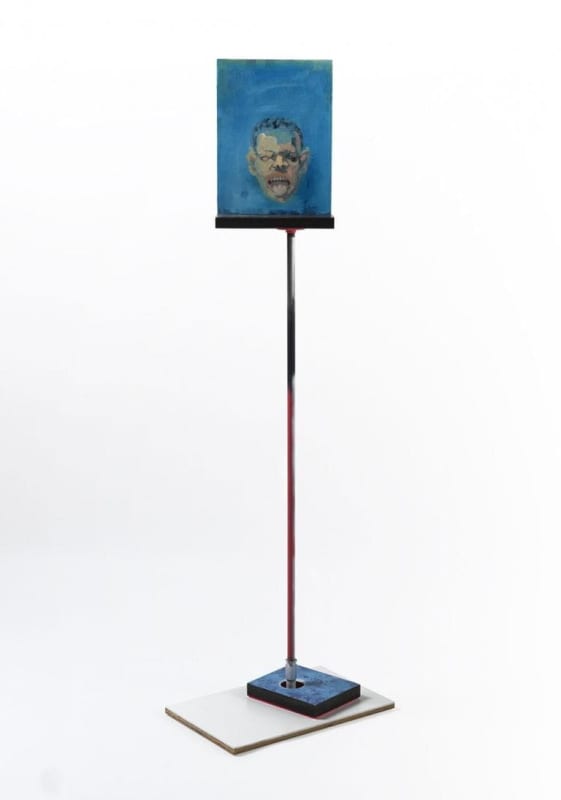The main motif in Steve Locke’s exhibition “There Is No One Left to Blame,” curated by Helen Molesworth, was the male head, sticking out its tongue in a gesture that’s half insouciant celebration and half angry fuck-you. Themes of masculinity and homosexuality, both important issues in the artist’s work, were certainly manifest in this exhibition, but color—in both its painterly and racial significance—was Locke’s main subject this time. The slipperiness of pigment, both on the surface of canvases and on bodies in the age of Obama, predominated. With portraits made for our purportedly postracial present, Locke revisits James Baldwin’s notion of whiteness as a cultural construction that depends upon blackness, by unsettling the fixity of color in his paintings. He situates his figures’ skin tones on a shifting chromatic spectrum, employing strangely mixed colors and multiracial features, and thus obstructing binary readings of race.
Painted with adept, brushy strokes, Locke’s heads are Goyaesque, but sweet colors abound. The grotesqueness of his figures’ visages is in contrast with the predominantly pastel- and jewel-toned palette and the artist’s use of decorative patterns. Backgrounds are often over-painted onto the figures, eating away at their boundaries, and colors run off the heads into their surroundings. At the ICA, numerous paintings were clustered together, salon style, with some either slightly sinking into or protruding out from the walls. Eight were mounted on anthropomorphic “bodies” made of metal pipe with wooden bases and situated throughout the room. Locke pays special attention to the edges and sides of his work, covering them with floral wallpaper or painting them with fluorescent pigments whose reflections stain the surrounding walls and floor. These various strategies transformed the show into an immersive environment—if figure and ground bled into each other in the paintings, the freestanding works took over the gallery space, seemingly implicating the viewer in contemporary debates about race.
The key to the exhibition was found in a cluster of three interrelated works. Two of the paintings on stands were arranged as if in conversation, or engaged in an allegorical face-off. The smaller of the two, All Received Wisdom, 2007–12, features a white figure with a half-open mouth, as if caught mid-declamation while soberly extemporizing, its base pushily overlapping that of its interlocutor. A Brief History, 2005–12, meanwhile, towered above, its racially indeterminate head looking out into space and ignoring its partner. A lizard-like tongue projects out of its mouth, and it has one eye closed, making its expression even more bizarre. Although not apparent from the front, an obsequious blackface figurine kneels on a platform attached behind the canvas. It is as if the head in the painting is tortured by ideas of discrimination and the continued, if diminished, authority of whiteness. The Rising Up, 2013, the biggest painting in the show, hung next to the two conversers. In it, a large, racially ambiguous head with a sloppily projecting tongue coalesces out of a vast field of the kinds of pinks that are still too broadly deemed “flesh” tones today. Whiteness is depicted here as a sickly blush that also colored the walls of the gallery itself: Locke mounted the piece on a beveled panel whose fluorescent-orange edge reflected onto the surrounding wall, creating a pink glow. Meanwhile, the faces found in other paintings pushed away from both whiteness and blackness, aggressively sliding between yellows, reds, even aquamarines.
By creating conflicts between paint on canvas and pigment on skin in these works, Locke defiantly navigates the boundaries between portraiture, decoration, and polemic with a rudely outthrust tongue. His figures are both angry and vulnerable. Protesting the multicultural dissolution that they nonetheless wear on their faces, they stick out their tongues at those who still try to fix color as an absolute marker of identity, while recognizing the difficulties of being caught in between.
...
Read full review at artforum.com.

